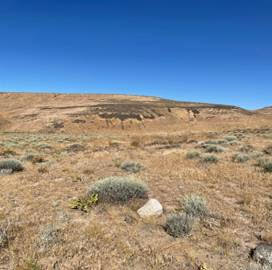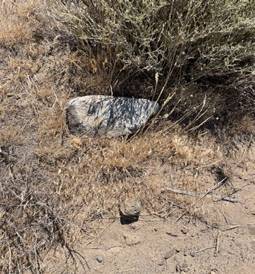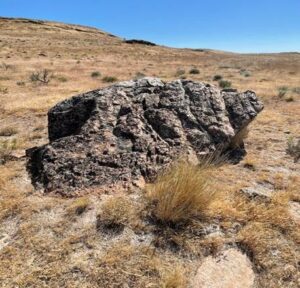In the approximate center of the state of Washington is the Gingko Petrified Forest State Park. And within the park is a trail, unnamed, which offers opportunities to view evidence of the terrific capabilities of the Ice Age Floods to transport huge boulders and leave huge deposits of rock material.

The trail is off I-90 at exit 136 to the town of Vantage. After exiting the freeway travel north through Vantage for almost a quarter mile and turn right onto Recreation Dr. There is a sign to “Rocky Coulee Recreation Area.” It’s the old Highway 10 leading down to Lake Wanapum. This 0.3 mile section of road from the turn is bisecting the western margin of an eddy flood bar. The bar is about 0.75 mi in length and 0.25 mi in width. It extends down to the recreation area. At the end of this 0.3 mile section of road is the trailhead on your left. Parking is available here. A Discover Pass is required. The road continues another quarter mile to the Rocky Coulee Recreation Area at which restroom facilities are available. You could also park there.
The trail starts along a slope above the Rocky Coulee. The bedrock here is all dark colored basalt. But deposited intermittently on the ground are light colored granitic rocks. Because they are not from this bedrock and are of a different composition than the basalt they are termed erratic. Where did they come from and how did they get here? That is the story of this hike.

The last outburst floods from Glacial Lake Missoula are thought to have happened about 15,000 years ago. Huge chunks of ice, icebergs, broke away and carried whatever rocky material they had impounded during years of emplacement. The icebergs likely came from the Cordilleran Icesheet as it failed.

This material was often granitic boulders and cobbles. Erratics here might have come from Rocky Mountain “Belt” bedrock or from glacial ice transporting Columbia-Okanogan valley bedrock and alluvium.
When the flood waters made their way to this location, some 200 miles from their origin near Pend Oreille, they encountered some constrictions in the terrain which slowed their progress. The most significant constriction affecting this area was Wallula Gap, 70 miles south. It was less than 2 miles in width. That sounds like a wide gap but it was enough to prevent free flowing of these huge floods. Another, but less significant one, was Sentinel Gap, 10 miles to the south. Upon the waters slowing, eddies formed and the icebergs got caught up in those. The temporarily impounded water backed up onto these slopes. This resultant body of water has been named Glacial Lake Lewis. Inevitably some of the bergs became grounded on the slopes in the area. The highest erratic here is at 1,263 ft. The maximum water depth was about 800 ft. That’s about 700 ft above the existing water surface of Lake Wanapum reservoir. In the adjacent Schnebly Coulee erratics go up 3.5 miles. It’s estimated Lake Lewis existed and then drained within a few days, probably no more than a week. Upon the water finally receding through the gaps, with much less energy than upon arriving, the icebergs were left behind. Over time the bergs melted leaving behind their loads. These slopes are littered with hundreds of erratics. As you walk you can spot them along the trail. Most of them are small to moderate in size: less than 3ft².
About a quarter of a mile into the hike the road starts taking a 90° right turn. As you round that turn you can see that Rocky Coulee below you takes a sharp turn to the south before again traversing to the east. It is quite possible the slope on which we are standing, a landslide, blocked the coulee and constricted that tributary’s water flow. As the water rose high enough to overcome the barrier it found a newer path to the south of its original course. We’ll see more evidence of the landslide up the trail.

In another quarter mile, about half way to our destination there is a group of erratics on the right of the trail. There is more than one within a 3 foot radius so that makes it a cluster. But with fewer than 10 rocks in a 30 foot transect and the ground surface not greater than 3 feet higher than the surrounding terrain this is defined as a Low Density Erratic Cluster. This is a definition derived by a Central Washington University Masters student, Ryan Karlson in 2006. It incorporates a definition given by Bruce Bjornstad.
At this same location you can look to the north and see a head scarp from a translational landslide. This whole hike is on a landslide. Looking to the east you can see hummocky terrain. So, there are 3 signs of landslide on this hike: head scarp, hummocky terrain, and the irregular tributary channel seen earlier.
The soil here is very thin and nutrient poor: lithosol. It forms from weathered basalt, windblown loess, and volcanic ash. (You can still find ash from the 1980 Mt St. Helens eruption). It mainly supports a few species of sagebrush and bunchgrass along with seasonal wild flowers. Among the fauna found here are deer mice and ground squirrels. There are abundant Elk droppings you will see when leaving the trail to reach the destination erratic. I have seen a video of an Elk herd I would estimate was well over a hundred, perhaps two or three hundred running across nearby terrain. It was incredible!

Traveling up the trail another quarter of a mile you can see the destination erratic off to the left on the trail. It will take about a quarter of a mile walk off the trail to get to it.
This erratic is the single largest one in the park area at 85 ft². It’s 10 feet long and 8.5 feet high. It lies in a High Density Erratic Cluster, so designated because there are more than 10 in a 30 foot transect and the terrain has less than a 3 foot rise. This is a typical elevation for an erratic of this size. It is not at the highest level. It makes sense that a larger erratic would be in a larger berg. And a larger berg would come to rest on a slope well before reaching the maximum height. High density clusters would need at least 45 feet of water.
Another category of erratic, and an intriguing one is bergmounds. It also requires 10 erratics in a 30 foot transect but accompanied by a greater than 3 foot topographic relief. There are only 3 bergmounds in this park area. and none are seen on this trail. The bergs transporting them would have needed at least 100 feet of water.

Even though erratics here are predominately granitic, there are other types such as quartzite, diorite, and gneiss. Walking back down the trail I was fortunate to spot a Quartzite found on the trail.
This hike is probably most pleasantly done on a nice spring day. The grass will be green and the wild flowers in bloom. If it’s done in the summer, as I did, it’s best to go in the early morning. Later in the day the ground can heat up and act as a secondary heat source in addition to the sun. Bring plenty of water, sun screen and a hat. The trail is cobbly so wear study walking shoes or hiking boots.
Back in the town of Vantage, on Ginkgo Ave. is the Gingko Interpretive Center. It’s a nice state park facility with displays of the Ice Age Floods, Columbia River Basalts, and the Petrified Forest. It is a good stop before or after the hike. It also requires a Discovery Pass.
Good Luck and Good Hiking.
Mike Doran, President, Ellensburg chapter of the Ice Age Flood Institute.
Information largely taken from Master’s Thesis by Ryan Karlson (2006):Investigation of Ice Age Flood Geomorphology and Stratigraphy in Ginkgo Petrified Forest State Park, Washington. Implications for Park Interpretation.
And also from Bruce Bjornstad’s On the Trail of the Ice Age Floods: A geological field guide to the Mid-Columbia Basin.
Thanks to Dr. Karl Lillquist for his advice and guidance.
